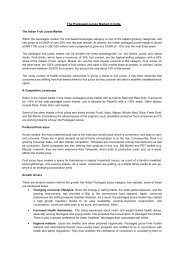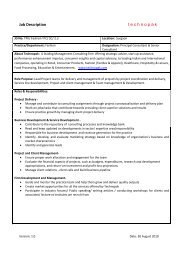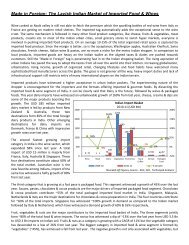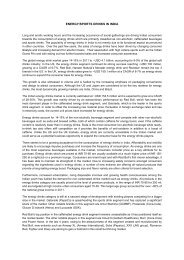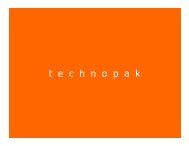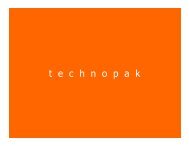INDIAN YOGURT STORY - Technopak
INDIAN YOGURT STORY - Technopak
INDIAN YOGURT STORY - Technopak
Create successful ePaper yourself
Turn your PDF publications into a flip-book with our unique Google optimized e-Paper software.
<strong>INDIAN</strong> <strong>YOGURT</strong> <strong>STORY</strong><br />
With the advent of functional products, and the emphasis on low calorie, low sugar, digestive products, the global dairy industry is<br />
undergoing a paradigm shift. Instead of the traditional milk, cheese, and butter concepts, more functional products such as yogurt,<br />
probiotics, etc. are now being accepted as the medium of delivery for beneficial functional ingredients.<br />
As per the GIA, the European and Asia-Pacific markets, which account for a more than 80% share of volume consumption,<br />
dominate the global yogurt market. Within the Asia-Pacific region, China is the fastest growing regional market for yogurt in terms of<br />
consumption (value and volume). As per Euromonitor estimates, emerging markets, including China and India, will contribute 95%<br />
of the global dairy market’s growth between 2011 and 2016.<br />
Yogurt, traditionally known as “Dahi” in India, has been a part of the Indian meal, with home-made dahi consumed daily. The Indian<br />
palate is well-accustomed to the taste of not only plain yogurt but also such form and taste variants as Lassi, Chaas, Srikhand,<br />
Mishti Doi, Raita, etc.<br />
In spite of being ingrained as the staple consumable, yogurt consumption in India lags far behind the average consumption in most<br />
developed markets. When compared to such high consumption markets as France (which sees an annual consumption of25 kg),<br />
Germany (24 kg), and Holland (23 kg), the per capita consumption in India is a meager 2.3 kg per year. Again, the per capita<br />
consumption of the packaged, store-purchased variety is 300 grams, and this too is heavily skewed toward urban India (~1 kg), and<br />
is near-zero in rural India<br />
MARKET EVOLUTION<br />
The Indian yogurt market is valued at an estimated INR 1000 crore, or ~USD 182 million, comprising organized, packaged yogurt<br />
and its varieties, packaged drinks, etc., and also the frozen yogurt service market. This is expected to grow at a CAGR of 20-25%<br />
with the expectation that it will double itself in the next three years.<br />
MARKET SEGMENTS: <strong>YOGURT</strong> MARKET<br />
Yogurt-based Products Spoonful Range Drinkable Range<br />
Packaged Retail Products<br />
Retail Service<br />
Plain/ Natural, Flavored Yogurt,<br />
Fruited, Probiotic Yogurt, Mishti<br />
Doi, Srikhand<br />
Flavored Yogurts with<br />
toppings like fruits, nuts,<br />
jelly, etc.<br />
Plain/ Natural Lassi,<br />
Flavored Lassi, Chaas<br />
Yogurt-based Smoothies<br />
In terms of segments, apart from the classical organized vs. unorganized, and product vs. service segmentation, the yogurt market<br />
can also be classified as the Drinkable range and the Spoonful range. Drinkable yogurt is emerging as a competition for flavored<br />
milk drinks and fruit/vegetable juice, while fruited yogurt is competing against the high calorie ice-cream. In terms of product share,<br />
plain/ natural yogurt constitutes the largest share and dominates retail sales, while such smaller categories as drinkable yogurt, and<br />
flavored and fruited yogurt, are likely to challenge specific packaged food and soft drink segments.
The packaged yogurt brands in action comprise two broad segments: national level players like Amul, Mother Dairy, Nestlé, and<br />
Britannia, which constitute about 80% of the total packaged yogurt market thanks to their distribution networks and product<br />
penetration, with the remaining 20% made up by such strong regional players as Karnataka Cooperative Milk Producers<br />
Federation, Parag Milk & Milk Products, Himalaya International, Tirumala Milk Products, The Nilgiri Dairy Farm, and VRS Foods,<br />
along with new international entrants in the markets e.g. Danone, Fonterra, etc. The space is expected to become more competitive<br />
with other major business houses such as Reliance, ITC, and CavinKare planning to enter the dairy space.<br />
The product offerings in the packaged segment range from plain yogurt to a plethora of varieties including probiotic, vitaminfortified,<br />
stirred, creamy, and pulp-laced, and span both the most basic of flavors like vanilla, mango, pineapple, and strawberry and<br />
also more exotic fruits such as raspberry and plum. In terms of pricing, INR 18-20 is the usual price point for a 100 ml cup.<br />
Packaged Yogurt & Other products<br />
1. AMUL Anand Milk Union Limited, the largest cooperative, launched the yogurt range in early 2011 with the<br />
“Flaavyo” brand. The range includes fruit-based flavors like Mango, Strawberry, Pineapple, and<br />
Vanilla, and also Mishti Doi (Sweet Curd)<br />
2 Nestlé Under the umbrella brand of “Nestlé Milkmaid”, their affordable yogurt range is tempting customers.<br />
Nestlé is playing it safe with two basic flavors of mango & strawberry in the market. The company<br />
also touches upon the health instinct of customers with the claim that the products as 98% fat-free.<br />
3 Mother Dairy Their wide distribution network in Delhi and Mumbai makes for great visibility, and, under the brand<br />
name “b-Activ”, they offer tailored Indian products like lassi & chach.<br />
4 Britannia After the success of Daily Fresh Dahi, Britannia further forayed into healthy, milk-based products<br />
with the launch of flavored yogurt in 3 exciting flavors, Mango, Vanilla, and Strawberry, which is<br />
fortified with 5 active nutrients, viz. Iron, Iodine, Calcium, Zinc, and Vitamin A, and is available in<br />
Mumbai, Delhi, and Bangalore.<br />
5 Danone Danone launched its creamy stirred yogurt in 2011 to target the health-conscious population in India,<br />
in three flavors - plain sweet, strawberry, and pineapple, at outlets in Delhi/NCR, Mumbai, Pune,<br />
Hyderabad, and Bangalore.<br />
The other existing but quickly emerging segment includes retail service brands like Cocoberry, Red Mango, Kiwi Kiss, and<br />
Yogurberry, which sell flavored/frozen yogurt through their exclusive/ standalone outlets stocking their respective brands and<br />
signature flavors. The retail service outlets are using modern trade institutions like colleges, schools, office canteens, airports, fivestar<br />
hotels, and independent kiosks, apart from traditional spaces such as malls, high streets, and popular markets, for tapping their<br />
target consumer group.<br />
Frozen Yogurt<br />
1. Cocoberry The brand enjoys the first mover advantage of retailing frozen yogurt in different flavors. It charges a<br />
premium over other brands, but consumer acceptance supports its widespread expansion across<br />
cities, and overseas. The company, which initiated operations in early 2009, has presence in 7 cities,<br />
with 32 outlets across India and plans to expand operations internationally as well. Strawberry and<br />
blackberry are the fastest moving flavors.<br />
2. Kiwi Kiss The Canadian yogurt brand predicted the potential of the Indian market and made a foray last year,<br />
with stores catering to the untapped south Indian consumer segment in Bangalore and Chennai.
3. Red Mango Frozen yogurt chain Red Mango entered the Indian market in 2012 and has plans to expand across<br />
the country by launching 15-20 outlets in the metros by 2013. It launched its first frozen yogurt brand<br />
to bring to India flavors such as Kiwi and Madagascar Vanilla, and claims to offer products made using<br />
calcium, protein, all-natural, nonfat or low fat, and certified gluten-free ingredients.<br />
4. Yogurberry The South Korean major expanded its operations to 16 countries in 7 years, and is now eyeing the<br />
Indian market. The company plans to open around 100 outlets over the next 5 years.<br />
One visible trend in the market is the rapid overlap of product offerings in both these segments with more varieties of flavored<br />
yogurt being offered by dairy brands to tap into the frozen yogurt market. Domestic players like Amul, on the one hand, offer frozen<br />
yogurt brands (Amul Flaavyo, in this instance) along with other offerings in the packaged fruited yogurt category. Nestlé also offers<br />
a range of fruited yogurts (branded as Nestle Real Fruit yogurt, in mango and strawberry flavors), while Mother Dairy’s fruited<br />
yogurts offer such flavors as blueberry, raspberry, and plum. At the same time, both new entrants and existing brands are<br />
enhancing their outlet reach to maximize the availability of their products.<br />
The surge in consumer demand is one of the prime drivers of the yogurt market’s growth. The rising awareness about lifestylerelated<br />
health concerns such as diabetes and obesity, and the benefits of yogurt, with its positioning as a health-promoting product<br />
that improves metabolism, has a positive impact on digestive mechanism, and enhances the immune system, ensures a repeat<br />
purchase. This awareness is complemented by the consumers’ willingness to try the new and innovative product offerings<br />
available, as a result of their wider international exposure. As a result, the conventional spoonful of plain yogurt is increasingly<br />
substituted by drinkable yogurt, organic yogurt, bio yogurt, or fruited / flavored yogurts.<br />
The consumer’s experimentation is supported by the changing nature of family earnings, especially the emergence of dual income<br />
households with higher disposable incomes, in terms of spending on products that were not considered imperative for daily<br />
consumption or used to be generally home-made.<br />
The other macro factors that are supporting growth include the wide availability of raw material that ensures an easy entry, and<br />
easy exit, from the market. The existing distribution network of established players and channel partners can be utilized to reach<br />
the final consumer, and the increasing reach of organized retail formats, in showcasing their extensive product range to a larger<br />
target audience, along with attractive packaging and competitive promotions, helps in enticing consumers to both for trials and in<br />
making repeat purchases.<br />
With the broad consumer acceptance of packaged yogurt and frozen yogurt products which satisfy their lifestyle and convenience<br />
needs, the market is expected to grow, encouraging more regional, national, and international players to enter the market. The<br />
existing players are making efforts to widen the consumer base, by, for instance, introducing pack sizes and variants at lower price<br />
points to target rural consumers.<br />
Authored By:<br />
Reetesh Shukla - Associate Director, Food services and Agriculture<br />
Vidul Sharma - Senior Consultant, Food services and Agriculture



